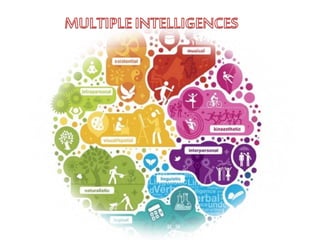
Multiple intelligences
- 2. Multiple Intelligences “Howard Gardner” Frames of Mind: The Theory of Multiple Intelligences At least 7 intelligences Human intelligence as having multiple dimensions that must be acknowledged and developed in education. Individuals are free to be intelligent on their own ways. Opposes the idea of labeling learners to a specific intelligence
- 3. The capacity to solve problems or to fashion products that are valued in one or more cultural setting. (Gardner & Hatch, 1989).
- 4. • The brain has other equally important types of intelligences. • The importance of assessing in an "intelligence- fair" manner. • Traditional examinations linguistic and logical skills In the past IQ tests measured only logic and language
- 6. LOGICAL-MATHEMATICAL Logic,abstractions, reasoning, numbers and critical thinking. Understanding the underlying principles of some kind of causal system. Puzzles & games,logical,sequential presentations, classifications, categorizations.
- 7. VISUAL-SPATIAL Aware of their surroundings and are good at remembering images. Great sense of direction. Learn best through drawings and visual aids.
- 8. BODY-KINESTHETIC Control of one's bodily motions and the capacity to handle objects skillfully. Learn better by involving muscular movement. Good at physical activities. Good at building things and like to stay active. Good motor skills and are very aware of their bodies. Hands-on activities, field trips & pantomime.
- 9. MUSICAL/RHTHMIC sounds, rhythms, tones & music able to sing, play musical instruments, and compose music. “auditory” :learn best via lecture use songs or rhythms to learn
- 10. INTERPERSONAL Interaction with others. Sensitive to others' moods, feelings, temperaments and motivations. Ability to cooperate in order to work as part of a group. (pairwok,project work, group problem-solving) Communicate effectively and empathize easily with others. Learn best by working with others and often enjoy discussion and debate. Gardner: “sales persons,politicians,managers ,teachers,counselors,social workers.
- 11. INTRAPERSONAL Introspective and self- reflective capacities. Having a deep understanding of the self; strengths/ weaknesses,what makes one unique. Being able to predict one's own reactions/emotions. Prefer working alone. Spends time thinking and reflecting. Psychologist, philosopher,writer, theologian Self-evaluation,journal keeping, options for home work.
- 12. VERBAL-LINGUISTIC Good at reading, writing, telling stories and memorizing words along with dates Talented with words. Ability to teach and explain things to others. Learn best by reading, taking notes and going to lectures. Note taking,story telling,debates.
- 13. Everyone can possess these intelligences. They are not equally developed. Teachers create activities which draws attention of all intelligences-to faciliate lg acquisition & realize their full potential.
- 14. Presenting every intelligence in every lesson plan is impossible as the list of intelligences growing.
- 15. For ex: Gardner (1999) has added an 8th intelligence.
- 16. NATURALISTIC Sensitivity to and appreciation for nature. Nurturing and growing things & the ability to care for and interact with animals. The newest added to the theory of Multiple Intelligences and is often criticized as being an interest rather than an intelligence. Gardener,Farmer,Animal Trainer,Scientist,Botanist,Zookeeper, Geologist
- 17. EXISTENTIAL Some proponents of multiple intelligence theory proposed spiritual or religious intelligence as a possible additional type. Gardner did not want to commit to a spiritual intelligence, but suggested that an "existential" intelligence may be a useful construct.[ Talented with words.
- 18. FIND A PERSON WHOSE …INTELLEGENCE IS DOMINANT
- 19. How to design a multiple intelligences lesson
- 20. There is no goals stated in MI. There is no syllabus(recommended). But there is a basic developmental sequence which can be considered as “syllabus design”.
- 21. • Multisensory experiences(touching,smelling etc.) • Learners can be sensitized to the many-faceted properties. Stage 1.Awaken the intelligence • Students are supposed to tell, share and bring their own experiences and objects into class and discuss them. Stage 2.Amplify the intelligence • This stage is the general “traditional" teaching phase with work done in group project worksheets and the amplified intelligence is used to solve the tasks and therefore enhance the learning Stage 3.Teach with/for the intelligence • Students reflect on their previous experiences and try to relate these tasks to other school or real life problems. Stage 4.Transfer of the intelligence Syllabus Design: According to Lazear (1991);
- 22. Multiple Intelligence projects: Based on one or more of the intelligences. Designed to stimulate particular intelligences. Curriculum–based projects: Based on curriculum content areas. Categorized according to the particular intelligences. Thematic- based projects: Based on theme from the curriculum or classroom. Devided into different intelligences. Resource-based projects: Designed to provide students with opportunities to research a topic using MI. Students-choice projects: Designed by students. Draw on particular intelligences. Nicholson- Nelson describes 5 types of projects used to individualize project work:
- 23. Learner’s Role Every learner is unique. The focus is on the learner and his or her different abilities to learn things. The learners develop their own personality. They are an active part in the classroom and they are aware of aims and achievements and reflect on their own learning.
- 24. Teacher’s Role Introducing students to the existence of multiple intelligences and guide them in identifying. Making use of all their intelligences through language learning activities that exercise the students' multiple intelligences.
